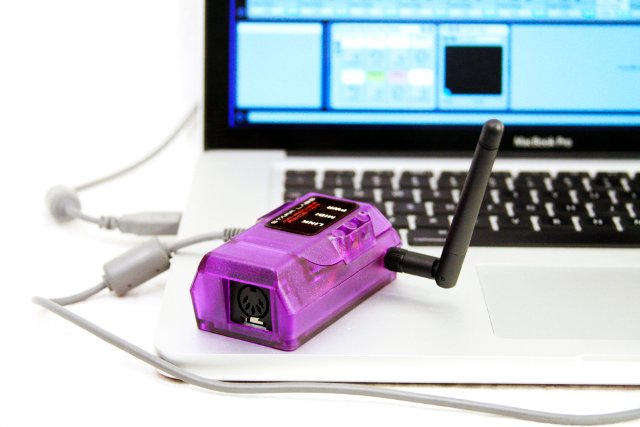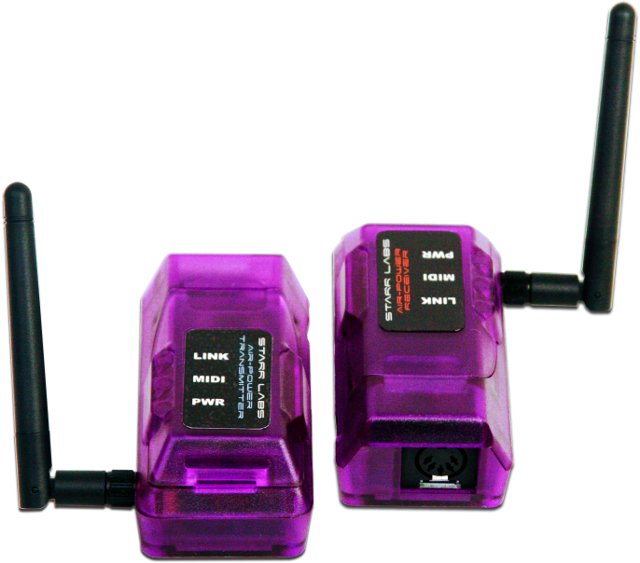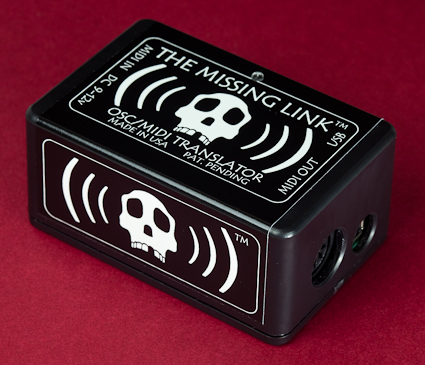Going wireless has long been a desire of musicians, but solutions have been slow to catch on. Two new products add wireless capabilities to your existing MIDI gear; I’ve talked to the creators to explain a bit about how their solutions work.
AirPower from Starr Labs uses proprietary 2.4GHz communication for wireless MIDI communication. The Missing Link takes a different approach, receiving OSC communication over a standard WiFi connection and translating to MIDI. Each approach has some potential advantages. The Missing Link you can use out of the box with wireless support from a mobile device, like an iPad or Android OSC controller. AirPower’s approach solves a serious reliability problem, by working with a more robust “no-dropout” connection link.
Starr Labs AirPower
Don’t knock cables – wireless can pose problems. Wireless MIDI solutions have to contend with dropped connections lasting just a fraction of a second. AirPower appears pricey – a US$425 upgrade or MIDI-only $250 adapter, each sold as a complete kit – but what you get is a more reliable connection. (Starr Labs has designed AirPower to work with their line of guitars and controllers, but with a MIDI connection and the $250 model, you can use whatever you like.)
Starr Labs’ Scott Caligure answers some of CDM’s questions; they’re also interested in collaboration.
On wireless MIDI and resistance to dropouts (partly quoting from their product literature), Scott explains:
The AirPower system is designed to recover from momentary dropouts in transmission without stuck notes or shutting off notes needlessly. Other MIDI wireless links often will shut off a note if the link goes down before a Note-Off message can be sent. Often the link only drops out for a small fraction of a second. Some manufacturers of low-cost Wireless MIDI wireless systems rely on MIDI Active Sensing being sent from the keyboard to the Receiver. In that case, if either the transmitting keyboard or the receiving synthesizer does not support Active Sensing, or it has been turned off; a disrupted wireless link will not be detected. That’s not a problem with the AirPower wireless.
The AirPower can be embedded easily within a Ztar, while embedding into a keyboard/synth does take some obvious aptitude. Of course it’s small enough to simply attach to any instrument.
The communication method is proprietary, but in this case, that’s a good thing, as it’s more resistant to external interference in the otherwise-crowded 2.4GHz band – a must if you’re using this onstage and not just in your studio:
Yes, we are doing our own proprietary communication. We utilize the extreme edges of the 2.4ghz range not only the ‘fat’ of this frequency.
There have been few isolated instances where a Verizon smartphone would cause limited interference. Otherwise, it tested convincingly in extremely ‘noisy’ environments i.e.; multiple RF mics, smartphones, other midi wireless units, on stage and in crowd etc…
What about interoperating with what they’ve done? Scott says Starr are very open to collaboration, and are particularly interested in talking to you here in the CDM community.
With concerns to other manufacturers wireless MIDI, this is an area we would love to connect/collaborate with people/companies. Of course, one could have 16 AirPower rigs running on stage or in studio at once. We offer a simple mod that makes the Airpower bi-directional allowing transmission from computer/laptop out to any MIDI device. We see this being used in multi-media installations, and gallery/museum settings where discreetness and/or site specific aesthetics are desired. Could also be used creatively with MIDI lighting rigs!
Starr has otherwise wireless news; I’ll put that in a separate story.
The Missing Link, Wireless OSC + MIDI
The Missing Link takes a different approach. It uses a standard WiFi radio, and translates OSC messages to external MIDI. Result: any computer, tablet, phone, or other wireless device that can send OSC messages it can understand can be connected to standard MIDI devices. This does just use a standard WiFi connection, so if you’re playing large gigs, I’d still be a bit wary of connection problems, as with any WiFi device. But for a lot of applications, I can imagine it’d be fantastic.
Price: US$150, available in a limited first production run of 100 units (meaning if you really want one, you may need to act quickly).
Specs:
802.11b WiFi
– adhoc or infrastructure modes
– open, WEP, WPA or WPA2 securityOSC via wireless UDP
– OSC to MIDI
– MIDI to OSC
– accepts multiple simultaneous connectionsMIDI
– MIDI IN/OUT (standard DIN-5)
– class-compliant USB MIDI IN/OUT
– configurable internal routing with soft MERGE/THRU
– all MIDI commands fully supported, including SYSEXPOWER
– 9V-12V DC, tip +/-, >=250mA
– or via USBPHYSICAL
– 3.3″ x 2.2″ x 1.6″
The project is produced by a small Portland group that came out of the local Dorkbot community, Jabrudian Industries. I asked Hans Lindauer about whether he’d considered open sourcing it (since, unlike the AirPower, this is a standard WiFi interface), and if he’d tested performance:
We have considered making it open source, and will likely do so in the future (but no promises here). We’re all big proponents of open source, but we also very much value a well-thought-out and finished product that “just works.” I’ve talked a lot with our programmer about it, and we both feel like the proper time to open the software is when he feels like no longer supporting it. At the moment, we’re very interested in seeing how people use the Missing Link and are motivated to honor feasible feature requests. From a hardware standpoint, if you look closely at the video you’ll see that the initial prototype was actually built from off-the-shelf Arduino components without modification. The magic here is in the firmware, which allows a huge amount of flexibility in controlling MIDI output based upon OSC input.
I’ll be doing a more scientific test of the latency as soon as we get back from NAMM, but subjectively there’s no noticeable latency. I’m actually having a difficult time figuring out how to measure when a finger contacts the touch screen, do you have any info on how that has been done by others? My idea is to amplify the tapping of my fingernail on the screen to one channel of a scope, and to measure the MIDI output on the other channel and compare the two, but even that introduces error because I can’t guarantee that the fingernail and fingertip will hit at exactly the same moment.
I’m, incidentally, very sympathetic to the first paragraph of that answer. All in all, it looks like a great project and potentially very useful indeed. If you pick one up, let us know.
An earlier version from September got a full video treatment:
And looking at both these solutions, it seems just as important will be opening up a conversation between everyone working on wireless devices of this kind, for better testing and discussion about implementation. That could help people improve performance in live and studio settings, and standardize implementation in such a way that devices can easily talk to each other. If you’re interested in such a conversation, let us know!


